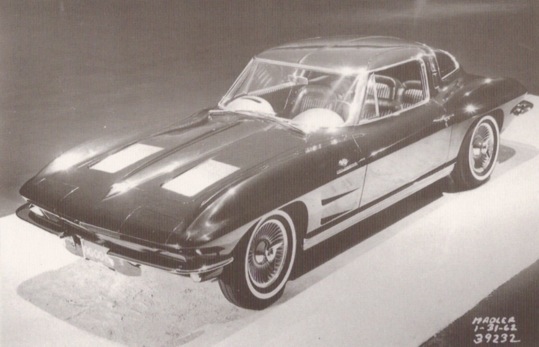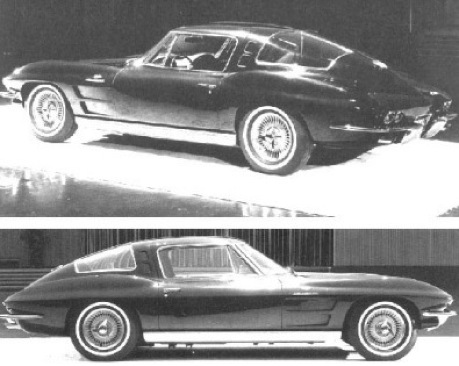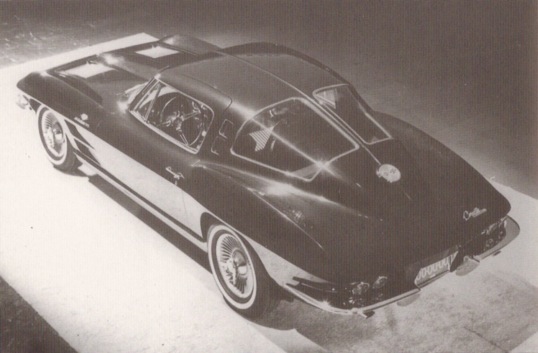
The Stingray that never was. The stretched version of this new Corvette model for 1963 has rear seating and was built as ordered by Chevrolet chief Ed Cole. Larry Shinoda designed this coupe, that never went into production because the demand for the two seated Stingray already was overwelming and nobody wanted a four seater.

This stretched Stingray prototype has a design that has great resemblance to the two-seater. You can hardly see the difference when comparing them.

Four-Passenger Corvette Or Full-Bore Ahead?
How Bunkie Knudsen Fended Off The 2+2 Corvette.
From the December, 2007 issue of Corvette Fever
By Ronald Ahrens
Photography by National Automotive History Collection
No sooner had Chevrolet Division General Manager Bunkie Knudsen successfully launched the Corvette Sting Ray in the summer of 1962, he then faced an unforeseen and distracting source of conflict. Entries made earlier that year in his diary show that he had already considered quitting his job; the subject would arise again before too long. As usual, the friction was originating with Knudsen's boss, Ed Cole, who in Knudsen's words, "was on the wild pitches again". To say Knudsen and Cole represented different ends of the spectrum is a feeble understatement, but it helps to explain their frequent clashes. Their arguments would lead Knudsen to consider the offer of Ford Motor Company's presidency, which came his way in early 1963. Yet the polarized opposition between the two men is only one reason Knudsen was bound to resist Cole's initiative for a four-passenger Corvette.
Knudsen grew up watching his father, William "Big Bill" Knudsen, rise to General Motors' presidency. Bunkie attended prep school and took his engineering degree at MIT. Meanwhile, Cole, a western Michigan farm boy, enrolled in General Motors Institute, but his engineering prowess was so great that he was pulled ahead into a job with Cadillac. He eventually procured many patents, including one for standing Chevy Vegas on their noses and loading them into trains. His son, the automotive industry analyst David Cole, remembers his father's constant sketching and tinkering. For relaxation, Cole hybridized orchids in his own greenhouse-probably, David thinks, because orchids represented the biggest challenge. Although he had begun in the manufacturing business by working on the shop floor, Knudsen approached engineering questions from the patrician manager's perspective; he rarely attempted even a do-it-yourself project around his manorial house. He was devoted to golf, scoring in the low 80s on his home course in suburban Detroit's Bloomfield Hills. He began many a day at the duck marsh, and he fished for mackerel off the Florida coast.
Adding to his skepticism about Cole was what Knudsen regarded as a lack of personal integrity. Not only had he discovered the slush fund Cole had used to obtain Ford's advance production schedules, but he also caught scent of a series of deals that gave off funny odors. Cole's arrangements with an executive of the Western Pacific Railroad looked "peculiar" to Knudsen. The contract Cole helped to get for his friend Jim Robbins, a seatbelt supplier, "smell[ed] to high heaven." (Robbins will resurface later in this series in connection with the CERV II.) One day after lunch, Knudsen reported that Cole had "showed us all a diamond Chevrolet pin he got from some Frenchman. About three months ago, [GM exec Cy] Osborn told me about how the pin came into being. Certainly-it should not be accepted. It's quite valuable."
But Cole had earned tremendous loyalty among the engineering and design staffs, as well as great influence among the top corporate managers, who recognized his long record of accomplishment and ignored his escapades. Even when he was tossing out unusual ideas, there would be an audience. And so Knudsen had to engage in the fierce and enduring fight to kill the four-passenger Corvette.
The subject first arises in his diary on August 23, 1962, the day after the new Sting Ray's national press preview. Cole must have thought a four-place Vette made as much sense as a similar Ferrari. But Knudsen only whiffed another odd-smelling deal. He considered the car useless, yet he had to go to the mat with the beast. On August 28, he wrote, "Went to Styling-cleared up four-passenger Corvette-told them to buy a 2+2 Ferrari. Mitchell feels this has correct dimensions. I told Mitchell I'd go along with him on dimensions but I did not want a different front-end from the Corvette. He agreed." In the six weeks before the issue was technically resolved, Knudsen churned out his increasingly common invective against corporate management. One session in Styling found him arguing with Dick Gerstenberg-who would eventually become GM's chairman and CEO-about exterior details of Chevrolet's '64 A-body coupe. He assumed the clay modelers who watched all this nonsense "must think we're nuts." The only considerations, he complained, were those related to cost-cutting and to Cole's nascent program to integrate operations of the automotive divisions. He indulged in his frequent lament about the "upper echelon in GM" and their arrogance, "The management is too self satisfied-too cocky-we can do no wrong-this is going to hurt because we're going to have to get a bump in the nose before we wake up. I hope it isn't a bad bump."
This theme was reiterated after a visit to Styling on Tuesday, September 4. Cole was reported still to be "hot" on the four-passenger Corvette. "Having trouble talking him into doing it right," Knudsen wrote. "It's getting more difficult working with Cole. He wants to run everything." First thing the next morning, Knudsen took the brand-new Ferrari 2+2 to Styling. Referring to the four-passenger Vette, he said, "Ours should be slightly larger." He came away from the meeting with Bill Mitchell feeling hopeful that an alliance had been struck with the Styling boss. While the Sting Ray was brilliant, Mitchell experienced problems with his designs for bread-and-butter cars, and Knudsen detected a flaw in Mitchell's strategy. "He starts out with a real far out car that he could never sell. Scares [chairman and CEO] Gordon and [president] Donner into being more conservative than ever."
The four-passenger car might have had only a few more weeks to live, but Knudsen evidenced discouragement by September 17. He again posed the theory that the car was a sop to be given to coachbuilders Mitchell Bentley, who were losing their job on the Buick and Oldsmobile station wagons. "I'm not going to battle," Knudsen said. "I'll give my views and opinion and then forget about it. Should let Cole hang himself. Why should I protect someone with as little integrity?" If anything lifted his spirits, it was visits from the likes of Mickey Thompson, whose great interest in LeMans was recorded, and from Jim Rathman the morning after a USAC race. "They led Milwaukee on Sunday," Knudsen observed, "but lost due to someone leaving off a gas cap."
In the third week of October, Knudsen took a call from GM Vice President Bud Goodman-probably his truest ally and confidant among top management-and was asked about the four-passenger Corvette. This was Knudsen's chance to disavow it. "It's the wrong thing to do," he told Goodman, feeling sure it would be turned down. Three days later, on Thursday, October 18, Knudsen tersely described the meeting in which the four-passenger Corvette was thrown out. "This is the correct decision," he wrote. Too big a man to gloat, he did permit himself a smile over Cole's theatrics. "Cole was mad at me because I never have wanted it. It was humorous because he was mad enough to threaten me with giving it to Olds if I didn't support him. I told him to go ahead."
Knudsen's next subsequent mention of the four-passenger Corvette was made after a New Year's Eve party, at which someone asked if Chevy was indeed putting out such a car, and he realized Cole had blabbed. And the vexing thing was, the car wouldn't quite die. When drafting up reasons why he was considering leaving GM, foremost among them was this undated screed, probably from February or March of 1963, "For some time now Mr. Cole has persistently asked me for a four-pass Corvette. Our Sales Dept-our advertising department and myself feel that a four-passenger Corvette will only ruin the Corvette image and not sell any great quantity. I have also asked our largest Corvette dealers, and they do not want a four-passenger Corvette. On arriving in town last weekend, I found in Styling Modeling a four-passenger Corvette. I understand this was Mr. Cole's instructions."

